Top>Research>Changsha Zoumalou Wujian (Zoumalou bamboo and wooden slips) and the Tama Hills—Exceeding Time and Space
 Index
Index

Yukinobu Abe [profile]
Education Course
Changsha Zoumalou Wujian (Zoumalou bamboo and wooden slips) and the Tama Hills
—Exceeding Time and Space
Yukinobu Abe
Professor of Ancient Chinese History, Faculty of Letters, Chuo University
Changsha, the eternal capital
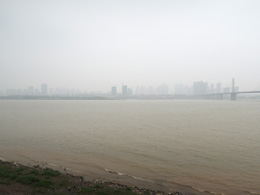
Viewing the opposite bank of the Xiang River from nearby Kaifu Temple. At the left-center of the photograph, a sandbar rises from the water.。
On March 12th, I visited Changsha for the first time in a long time. Located in southern China, Changsha City is the capital of Hunan Province. The Xiang River flows languidly through the city from south to north. In the book Hunan Fan of Words, Ryunosuke Akutagawa depicts the encounter with Gyokuran while riding a motor boat afloat in the Xiang River. Although the motor boat is no longer in operation, the river bustles with a never-ending stream of large cargo ships and small ferry boats.
North of Changsha City, the Xiang River flows into Dongting Lake, China’s second-largest freshwater lake. The Chinese characters used to write the Hunan have the meaning of lake and south, thus referring to the province’s location. When going upstream to the southward and passing through Mao Zedong’s hometown of Xiangtan County, you will reach Hengshan (Mount Heng of Hunan), which is the holy ground of Taoism. In the past, Zen Buddhism flourished in the region around Hengshan, otherwise known as Xiangnan. Together with the name of this region, Zen Buddhism was introduced to Japan in the Kamakura Period.
For more than 2,000 years, Changsha thrived as the center of water transportation connecting mountainous regions, and as an important transportation point connecting the middle basin of the Yangtze River with the South China Sea. Of course, the Xiang River was the key to that prosperity. In recent years, Changsha has developed even further together with the growth of mining and manufacturing in the Xiang River basin.
Impact of Zoumalou wujian
Upon arriving in Changsha, I first made my way to the Heiwado Building located in Wuyi Square, the foremost shopping district in Changsha. Heiwado was violently looted during the anti-Japan demonstration that occurred on September 15th, 2012. The looting was widely reported in Japan. Today, the entrance hall of the building contains a booth which celebrates the 30th anniversary of the friendship agreement between Shiga Prefecture and Hunan Province. The shadow of the violent events has completely vanished. Actually, 18 years ago, this building was the site of news which shocked the academic world.
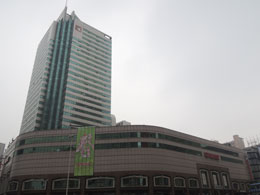
Heiwado Building
In 1996, wooden fragments inscribed with writing were discovered mixed in with earth excavated from the construction site of the Heiwado Building. A subsequent survey revealed that the area was scattered with ancient wells used by government offices in the past. Even more, buried within one of those wells were hundreds of thousands of wooden slips and bamboo slips from the Three Kingdoms Period (220 to 280). This group of materials was named Zoumalou wujian (Zoumalou bamboo and wooden slips) in reference to the name of the discovery site. Wujian means wooden and bamboo slips from Wu. This indicates that the writings were from the state of Wu, which is one of the Three Kingdoms and had its capital in what is now Nanjing.
In recent years, in the basin of the Xiang River and its tributaries, these kinds of ancient material have been discovered one after another together with development in the area. In particular, the position of Changsha City has not changed for over 2,000 years, a feature which led to the Zoumalou xihanjian (2003) and the Dongpailou hanjian (2004) being excavated successively in a small area which is within 10 minutes walking distance. In 2010, the Wuyi-guangchang donghanjian was discovered at a subway construction site just north of the Heiwado Building. All of these discoveries have immeasurable academic value. Especially noteworthy are the Zoumalou wujian. In addition to the exceptional number of these slips, the fact that they are from the Three Kingdoms Period has attracted great attention.
When compared to the popularity of the historical novel Sanguo yanyi (Romance of the Three Kingdoms), the Three Kingdoms Period is clouded in mystery. This is due to the vagueness of the historical document Sanguozhi (Records of the Three Kingdoms). In the first place, since it is thought that the use of paper was widespread during the Three Kingdoms Period, the use of so many wooden slips and bamboo slips is unthinkable from historical writings. Accordingly, it is only natural that researchers had high expectations for the Zoumalou wujian.
Current conditions of research on the Zoumalou wujian
However, as research progressed, it became clear that the situation was much more complicated.
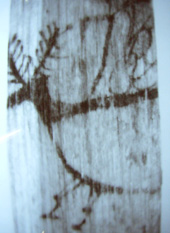
A deer drawn on the Zoumalou wujian. Shown as an infrared image enlarged on a computer screen.
Without question, hundreds of thousands is a large number of slips. However, upon further examination, the overwhelmingly majority of the slips were found to be fragments of family registers and receipts of government offices. Of course, the excavation of such material has extremely great significance in terms of understanding the form of administrative documents in ancient China. Even so, in the case of a vast number of similar documents which only differ in the listed names, numbers and dates, there are simply an increased number of examples which don’t provide any new knowledge. The situation would be different if the documents were discovered as a coherent ledger, but they were actually unearthed as scattered scraps. Although it is possible to put written texts in order according to contents, it is extremely difficult to restore this kind of ledger to its original form. As a result, an image of the Zoumalou wujian as an “overwhelmingly vast number of materials which is difficult to handle” has taken root in academic circles. Currently, the number of theses addressing the Zoumalou wujian is quite small when compared to other excavated literary material.
Even so, it is too early to give up. At any rate, a ledger is simply a raw memorandum of information which has yet to be selected and organized. If we were able to somehow elicit the potential of this material, we would acquire a realistic image of actual living conditions in ancient Changsha, something which couldn’t be garnered from literature. Although progress is slow, diligent effort continues to be made.
Landscape of a farming village in 3rd-century Changsha
For 3 days starting from March 15th, I confined myself to the workroom of the Changsha Bamboo Slips Museum where the Zoumalou wujian are housed. As much as time allowed, I devoted myself to observation and analysis of the material. Photographs of my work were introduced on the homepage of the Changsha Bamboo Slips Museum. (http://www.chinajiandu.cn/Company-News/2117.html![]() )
)
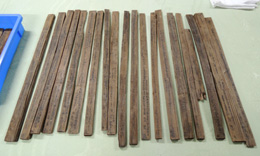
Limin tianjiabie
Within the Zoumalou wujian, my research focused on large wooden slips known as Limin tianjiabie. For each household, these slips show a detailed record of the farming area and the taxed amount/payment date for rice, cloth and currency according to the grade of the harvest. Related calculations are also listed.
According to the Limin tianjiabie, the residence and farming area of people living during that time were grouped in units known as Qiu. Based on analysis of the Limin tianjiabie and excavated material from the Warring States Period, it is now apparent that Qiu does not refer to hills, but rather to the open area located in the valley between hills. In such areas, the slash and burn method was used to prepare farmland. Fallowing and burning was performed repeatedly within a fixed circle. Since the Limin tianjiabie was prepared annually, it is possible to analyze changes in farming area, or movements in farmland, by comparing yearly data for the same individual. At the same time, the wording Huozhongtian (farmland made arable by burn) is seen in some parts of the Limin tianjiabie. Therefore, it can be said with near certainty that slash and burn methods were used.
The Zoumalou wujian also contain many records regarding deerskin. Attracting particular attention is the skin of roe deer which live in thin forests. As the result of repeated forestry development performed using slash and burn methods, grasslands with shrubbery spread in between farmland and forests around there. Most likely, there was an increase in roe deer that prefer such an environment.
One can imagine a landscape in which the Xiang River sparkles in the sunlight, flowing through hilly country which extends as far as the eye can see. Grasslands spread through the valleys between hills which stand over the forest. You can see rice fields in places there. Small deer appear in the grasslands and eat the flowers of shrubbery. The shadow of fish—perhaps carp— can be seen flitting through large lakes at the foot of the hills. Passing by the lake are cows carrying hemp.—By examining the ledger of Zoumalou wujian, one can envision a panoramic farming landscape which cannot be seen from the Sanguozhi.
Zoumalou wujian and the history of Tama
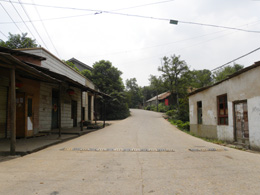
Scene of Chong region in the suburbs of Changsha City
At the same time that the Limin tianjiabie was created in Changsha, an envoy from Himiko visited state offices of Wei on the distant Korean Peninsula. During this time, the culture of rice production was spreading to the Japanese archipelago.
Afterwards, in the hilly regions of eastern Japan, farmers began to perform slash and burn agriculture using the erosion valleys of the hills. This scenery overlaps with the landscape in 3rd-century Changsha. In the Tama Hills of Japan, such land was called Yato or Yatsu. Both in geography and name, the vestige of Yato remains in the Yatsu-iri village which is located along the road leading from the main gate of the Chuo University Tama Campus to the Yaen Kaido route. In the Changsha region, one frequently encounters the regional name Chong, which is believed to run through Qiu. The landscape and farming land which lies in that region is similar to Yato.
The more I examine the Zoumalou wujian, and the more that I learn about the history of Tama region, the more I vividly feel the flow of a great fundamental culture which connects mainland Asia and the Japanese archipelago. I was born and raised in Tama, and today I teach in Tama. Accordingly, while holding a ledger from 1,800 years ago, I was suddenly filled with a sense of fate regarding my encounter with the Zoumalou wujian.
- Yukinobu Abe
Professor of Ancient Chinese History, Faculty of Letters, Chuo University -
Born in Kunitachi City, Tokyo Prefecture in 1972. In 1991, graduated from Tokyo Metropolitan Chofukita High School. In 2002, completed the Doctoral Program at the Graduate School of Humanities and Sociology, University of Tokyo. Holds a PhD in literature from the University of Tokyo. After teaching at the Fukuoka University of Education and Japan Women’s University, became an Associate Professor at the Chuo University Faculty of Letters in 2008. Assumed his current position in 2009.
Based on hints including the government, society and systems (uniform regulations, tax systems) of the Qin-Han Dynasties and the Wei-Jin-Nanbeichao (Southern and Northern) Dynasties, conducts research on the formation and growth of the Chinese cultural sphere from the perspective of relations with surrounding regions.
In addition to general writings such as China from a Historical Perspective (edited by Seiichiro Yoshizawa; Foundation for the Promotion of The Open University of Japan, 2013), has published numerous theses in academic journals in Japan and overseas. Currently appears in The Open University of Japan’s television class China from a Historical Perspective.
- Research Activities as a Member of Research Fellowship for Young Scientists (DC1), Japan Society for the Promotion of Science (JSPS) Shuma Tsurumi
- Important Factors for Innovation in Payment Services Nobuhiko Sugiura
- Beyond the Concepts of Fellow Citizens and Foreigners— To Achieve SDGs Goal 10 “Reduce Inequality Within and Among Countries” Rika Lee
- Diary of Struggles in Cambodia Fumie Fukuoka
- How Can We Measure Learning Ability?
—Analysis of a Competency Self-Assessment Questionnaire— Yu Saito / Yoko Neha - The Making of the Movie Kirakira Megane








